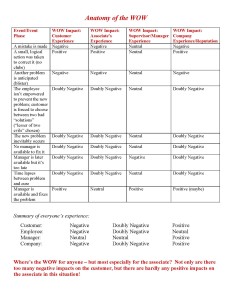Whenever we talk about WOWing our customers, it’s easy to just say, “That was a WOW” or “That was an OW,” without breaking an interaction down into all its elements and every touchpoint along the way. It’s almost never a simple case of one thing that went right or wrong to create the experience.
So, today I’d like to share a story and show you how a simple template I call “The Anatomy of the WOW” can help you identify each touchpoint, the experience for everyone involved, and how to determine where your service recovery policies, prescribed actions, scripts (and more) may need tweaking.
First, keep in mind that at every touchpoint, there are varying experiences for each person/ entity involved: namely, the customer, the associate dealing with the customer, the associate’s manager/supervisor, and the company as a whole.
Here’s the story: A couple booked a week at a golf resort, where they not only booked their room, but also booked a week of lessons at the resort’s golf academy and rounds of golf at their course. On the morning of their first lesson, the couple went to the golf academy, where their bags were supposed to be waiting for them. But only the man’s golf bag was there; the woman’s bag had been misplaced.
While resort personnel searched for the missing bag, the woman was obviously given a set of clubs to use – a very standard service recovery policy. No problem there (other than the missing bag).
However, the woman’s golf glove was in her bag, and without it she risked getting a blister. The associate working with her didn’t have authority to give her a glove. They tried to find the manager to authorize the “gift” of the glove, but no one was around, so the associate offered to sell her one from the Pro Shop (it cost $30). She declined… and the inevitable happened. She got a blister. The associate got her a bandaid, and then took it upon himself to give her a glove (without authorization) to prevent another blister, hoping it would be OK with the manager when he told him about it later.
The following day, they did find her bag and glove, and the manager did approach her to apologize and tell her she wouldn’t be charged for the glove. But what had happened by that time? Rather than the gift of the glove creating a WOW, which would have been the case if she’d been given it right at the start of the problem, the situation became a matter of, “Well, it was the least they could do!” simply because no service recovery policy was in place to allow an associate the ability to use his judgment and do what was right. After all, the couple was spending thousands of dollars at the resort in one week… what was a $30 (retail) glove compared to that?
Also, what happened via word-of-mouth that night, when they were dining with many other customers who saw the bandaid and then heard the “OW!” version of the story, rather than the “WOW!” version? And what of the many friends who heard it when they returned home?
This golf resort is an excellent one, and they believed they had the proper service recovery policies in place to handle any situation. But without examining each incident for small improvements that can be made, even excellent companies can miss opportunities to WOW their customers.
What’s more, they miss opportunities to allow their associates to participate in – and feel good about – their service. Look at the template below that outlines each party’s experience at each touchpoint of the interaction (click on the image to make it larger so you can read it):
The upshot is that if we want our associates to even try to WOW customers, we must provide them with the tools, policies and procedures that allow them to do so. Examine your service and service recovery policies. Analyze each interaction. Where can it be improved – for anyone (and everyone) involved?
Don’t allow your associates to be embarrassed during an interaction, only to have a manager or supervisor “swoop in” and save the day, leaving the associate red-faced over his or her inability to create a WOW (or even just to prevent an OW) right from the start… while also allowing enough time for a customer to spread an OW version of an experience via word-of-mouth, rather than the WOW!


